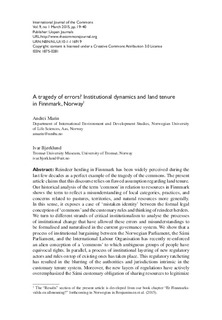| dc.description.abstract | Reindeer herding in Finnmark has been widely perceived during the last few decades as a perfect example of the tragedy of the commons. The present article claims that this discourse relies on flawed assumption regarding land tenure. Our historical analysis of the term ‘common’ in relation to resources in Finnmark shows the term to reflect a misunderstanding of local categories, practices, and concerns related to pastures, territories, and natural resources more generally. In this sense, it exposes a case of ‘mistaken identity’ between the formal legal conception of ‘commons’ and the customary rules and thinking of reindeer herders. We turn to different strands of critical institutionalism to analyse the processes of institutional change that have allowed these errors and misunderstandings to be formalised and naturalised in the current governance system. We show that a process of institutional bargaining between the Norwegian Parliament, the Sámi Parliament, and the International Labour Organisation has recently re-enforced an alien conception of a ‘commons’ to which ambiguous groups of people have equivocal rights. In parallel, a process of institutional layering of new regulatory actors and rules on top of existing ones has taken place. This regulatory ratcheting has resulted in the blurring of the authorities and jurisdictions intrinsic in the customary tenure system. Moreover, the new layers of regulations have actively overemphasized the Sámi customary obligation of sharing resources to legitimize the new, ambiguous, conception of commons. This process is explained as one of institutional bricolage based on naturalisation by analogy and authority processes that allow certain powerful actors to influence the production of institutional arrangements favourable to them. All three processes underline the negotiated, dynamic nature of institutional change. We propose this integrative analysis of institutional and general social dynamics is beneficial in studying commons as everyday practices affecting natural resource governance. | nb_NO |

